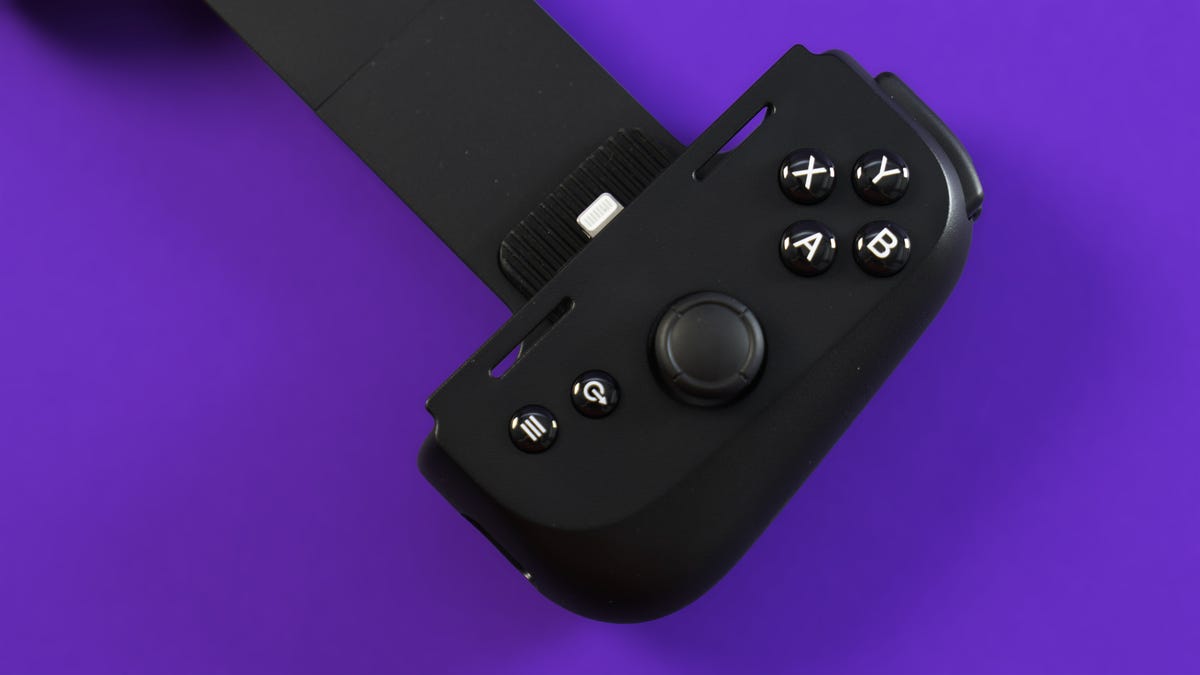Just like the Backbone One PS5 Edition controller is nearly identical to the standard model, Razer’s Kishi V2 for iPhone is identical to the Android-compatible model from earlier this year. The connectors are the only difference in the Kishi V2 for iPhone, which has MFi-certified Lightning for both the phone connection and the power passthrough connector. The Backbone One and Razer Kishi V2 have similar hardware, different software and (unsurprisingly) the same $100 price.
Like
- Controls feel more responsive than a lot of alternatives
- Easy on/off phone mounting design
- Nexus app lets you remap buttons and link to Facebook or YouTube for streaming
- 2 programmable buttons
Don’t Like
- Allows passthrough charging, but you lose audio support
- Grips could be a bit larger and grippier
- App needs work
The controller is compatible with any iPhone with a Lightning connector and running iOS 15.4 or later — as far back as the iPhone 6. Like the Android version, you can adjust for thicker phones by removing the rubber bumpers on either side. That does make me a little nervous, since it means the plastic is up against the metal of the phone in a few spots.
Though Razer doesn’t guarantee it will work with a phone case — an important feature none of these split controllers guarantee — I did get it to work with a thin case. Once. The next time I tried, the connector didn’t seem to be able to reach far enough; annoying, since I bought this case specifically for these controllers because my normal case for the iPhone 13 Pro is too… protective.
Otherwise, the Kishi V2 for iPhone functions and feels identically to the Android model. Like the Backbone One, the Kishi is essentially a split Xbox-layout controller with a plastic expander connecting the two sides. You slip your phone in, plug the Lightning port into the matching connector and pull the left side to match the top of the phone, which is kept in place by tension and the plastic bridge. The controller draws power from the phone, though it doesn’t seem to pull a lot, and uses the Lightning connector for low-latency response (relative to Bluetooth). It can charge via a passthrough connector, but it doesn’t support audio through that.
In addition to triggers and bumpers at the top, there are small mappable buttons. I like having extra buttons, because I like to avoid having to click via the thumbsticks, which for me usually results in unwanted movement. The trade-off is the triggers are on the small side, though they don’t feel too small and are sufficiently recessed that you won’t hit them when reaching for the buttons. And they have nice tension, better than some full-size controllers I’ve used.

The only difference between the Android and iPhone versions of the controller is the Lightning connectors.
Lori Grunin/CNETIt uses an iOS version of Razer’s Nexus app, which allows you to rebind the controls globally. That’s a nice feature, but the app is otherwise is uninspiring. It’s not great at managing games: You can’t organize your favorites or recents, and its discovery suggestions are only for iOS games that support controllers — no cloud games, no search. There isn’t even a section for Apple Arcade games. It does list a few Netflix games, though those are also written for iOS.
The hardware is similar to the Backbone One, but the Backbone’s software is smarter, which gives it a decided advantage especially if you’re a seriously social gamer. I like the Kishi V2 for iPhone, but the hassle of using these split controllers with phone cases keeps driving me back to the full-size clip-ons.